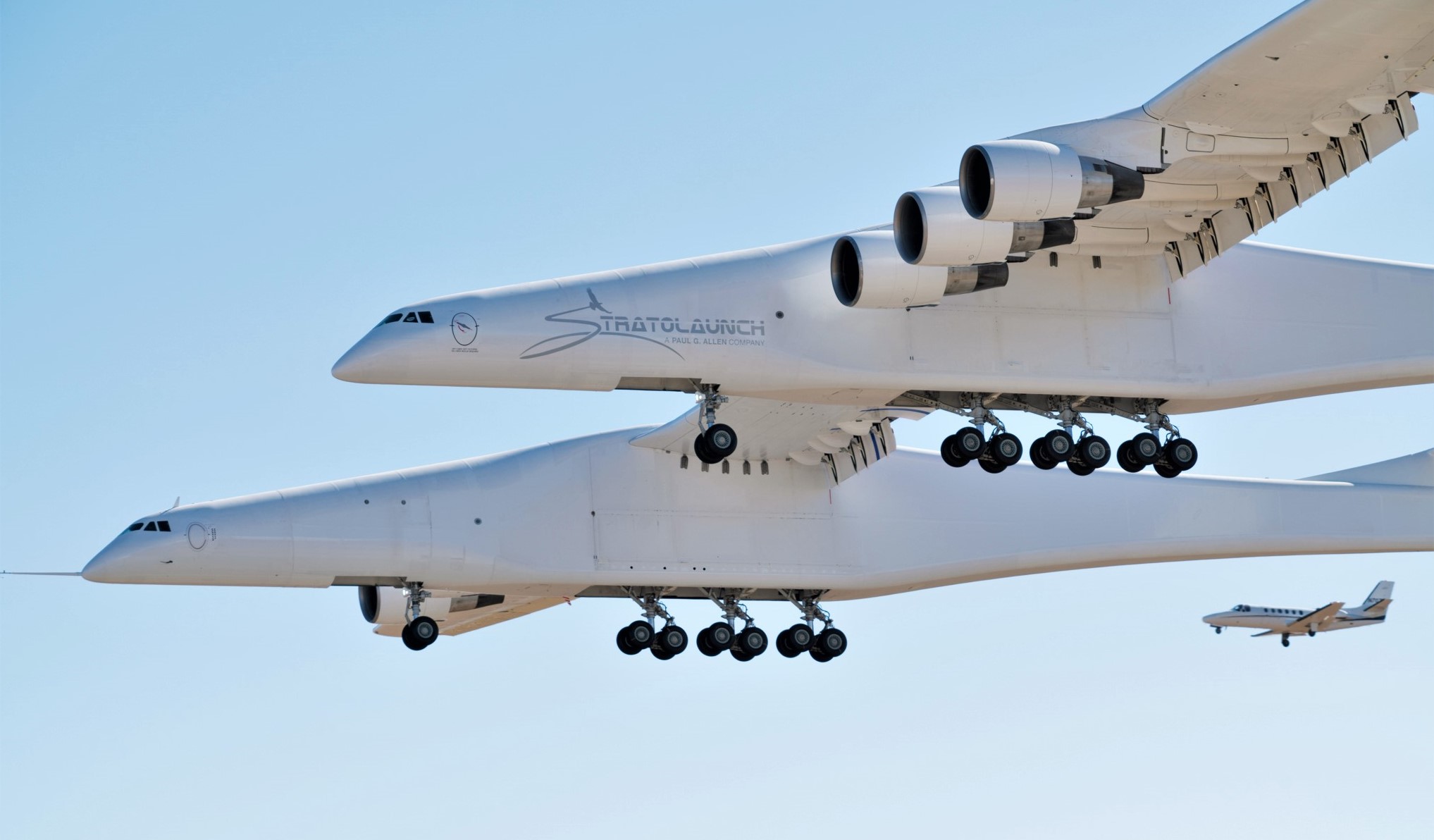
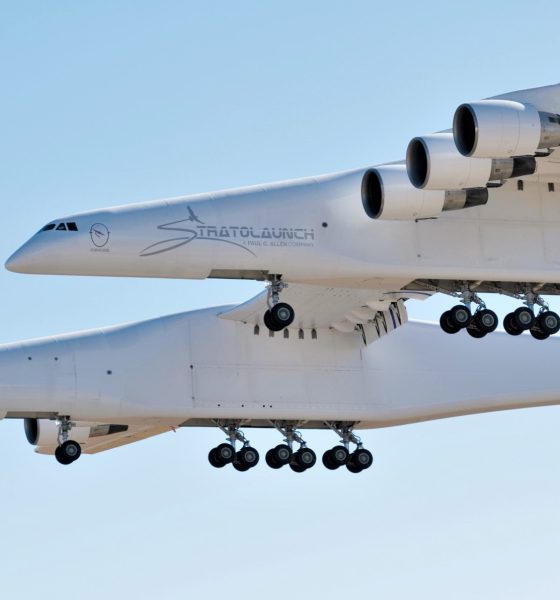
News
Stratolaunch sold to mystery buyer, raising hopes that world’s largest plane will fly again
Stratolaunch Systems Corp. – a space launch venture created by the late Microsoft co-founder billionaire Paul Allen – debuted the world’s largest plane (nicknamed Roc) in April 2019, completing one flawless flight before reports of its indefinite grounding arose.
In June, parent holding company Vulcan Inc. – led by Allen’s sister after his death – planned to cease Stratolaunch’s operations in anticipation of a total liquidation – including the aircraft, intellectual property, and facilities – worth up to $400 million. However, the Roc may live to fly once again after an official October 11th announcement, in which Stratolaunch indicated that the company has “transitioned ownership and is continuing regular operations.”
Prior to the announcement, NASASpaceflight.com photographer Jack Beyer posted photos to twitter appearing to show new activity at Stratolaunch’s Mojave Air and Space Port hangar. The post garnered a response from Nicola Pecile – test pilot with Virgin Galactic – who stated that operations seem likely to resume “in a few weeks” citing that hiring notices were recently sent to members of the Society of Experimental Test Pilots (SETP).
Initially, Allen developed the company to launch air-to-orbit rockets from a carrier aircraft mid-flight. To say that Stratolaunch has experienced turbulence during development may be an understatement. Since its inception, conceptualization redesigns and failed partnerships with various rocket launch vehicle companies have plagued operational efforts.
In 2011 Stratolaunch partnered with Elon Musk’s SpaceX to develop a multi-stage launch vehicle named the Falcon 9 Air that would be dropped from a carrier aircraft. The Falcon 9 Air would have been capable of delivering payloads up to 6,100kg (13, 400lbs) to low Earth orbit (LEO) from flight altitudes of 30,000ft with the assist of 4 Merlin 1D engines – the same engines that now propel SpaceX’s Falcon 9 and Falcon Heavy boosters.
In 2012 SpaceX and Stratolaunch amicably parted ways with SpaceX citing design alterations that no longer worked with their envisioned Falcon 9 Air launch vehicle.

Following the dissolution of the partnership with SpaceX, Stratolaunch partnered with Orbital Sciences Corp (Orbital ATK) – now a subsidiary of Northrop Grumman – to develop the Pegasus II which was ultimately shelved to pursue in-house developed launch vehicles. Following the death of Paul Allen in 2018 that plan was also abandoned as Allen’s sister, Jody Allen, set an exit plan for the company in early 2019 according to Reuters.
However, the recent buy out by a mystery purchaser has seemingly breathed new life into Stratolaunch as the Twitter announcement also mentioned that the company will now “bring the carrier aircraft test and operations program fully in-house.” What this means for the future of the Roc and any air-to-orbit launches remains unclear.
The Roc itself is comprised of twin fuselages connected by a reinforced center wing and features an incredible wingspan of 117m (385ft), 28 landing gear wheels, and six Pratt & Whitney PW4056 engines – as well as many other components – salvaged from donor Boeing 747-400s. It is both the largest and heaviest aircraft (excluding payload) to have ever flown.
With a nickname derived from a mythical bird so large it could carry an elephant in flight, it would have been a tragedy if the one-of-a-kind aircraft were to be scrapped, mothballed, or placed in a museum after just a single flight. With Hope Stratolaunch’s October 11th announcement, the future of the massive plane has thankfully stabilized in spite of significant uncertainty, and hope remains that Roc’s new owner(s) will find a way to continue flying the aircraft.
Check out Teslarati’s newsletters for prompt updates, on-the-ground perspectives, and unique glimpses of SpaceX’s rocket launch and recovery processes.

News
SpaceX reaches incredible milestone with Starlink program
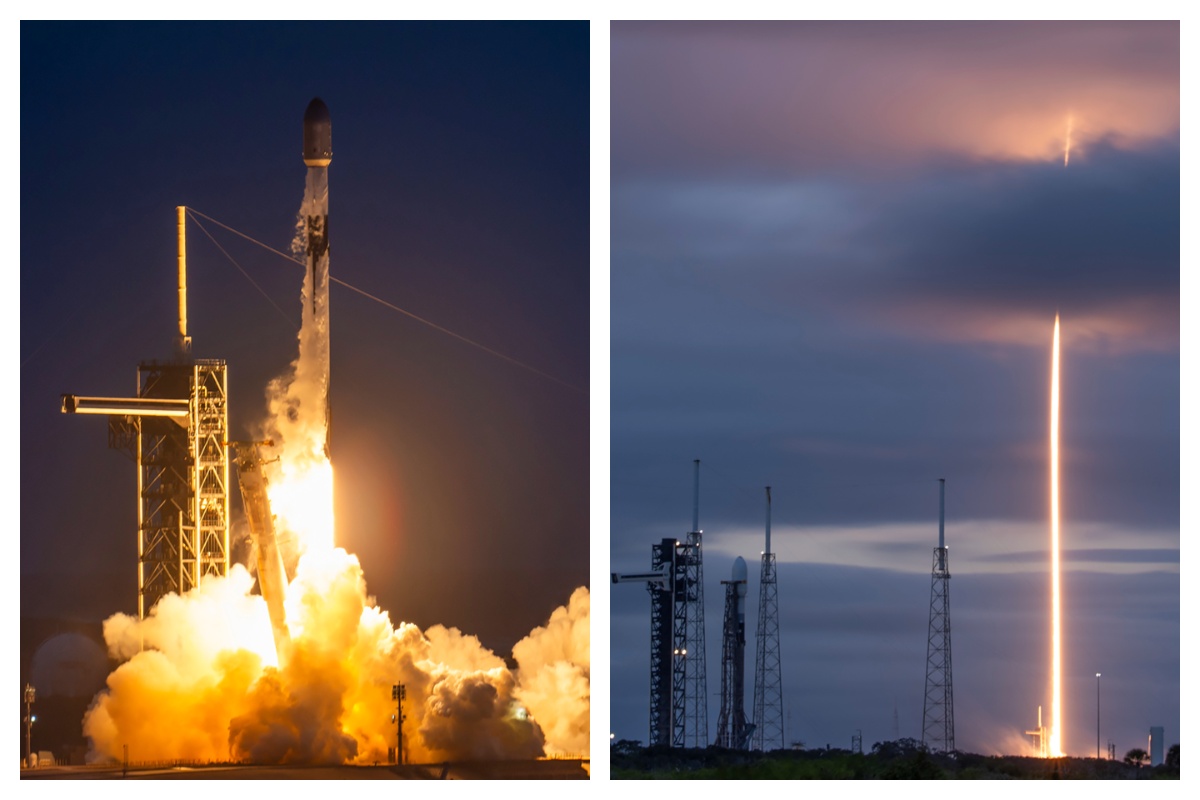
SpaceX reached an incredible milestone with its Starlink program with a launch last night, as the 3,000th satellite of the year was launched into low Earth orbit.
On Monday, SpaceX also achieved its 32nd flight with a single Falcon 9 rocket from NASA’s Kennedy Space Center.
The mission was Starlink 6-92, and it utilized the Falcon 9 B1067 for the 32nd time this year, the most-used Falcon booster. The flight delivered SpaceX’s 3000th Starlink satellite of the year, a massive achievement.
There were 29 Starlink satellites launched and deployed into LEO during this particular mission:
Falcon 9 launches 29 @Starlink satellites from Florida pic.twitter.com/utKrXjHzPN
— SpaceX (@SpaceX) December 9, 2025
SpaceX has a current goal of certifying its Falcon boosters for 40 missions apiece, according to Spaceflight Now.
The flight was the 350th orbital launch from the nearby SLC-40, and the 3,000 satellites that have been successfully launched this year continue to contribute to the company’s goal of having 12,000 satellites contributing to global internet coverage.
There are over five million users of Starlink, the latest data shows.
Following the launch and stage separation, the Falcon 9 booster completed its mission with a perfect landing on the ‘Just Read the Instructions’ droneship.
The mission was the 575th overall Falcon 9 launch, highlighting SpaceX’s operational tempo, which continues to be accelerated. The company averages two missions per week, and underscores CEO Elon Musk’s vision of a multi-planetary future, where reliable connectivity is crucial for remote work, education, and emergency response.
As Starlink expands and works toward that elusive and crucial 12,000 satellite goal, missions like 6-92 pave the way for innovations in telecommunications and enable more internet access to people across the globe.
With regulatory approvals in over 100 countries and millions of current subscribers, SpaceX continues to democratize space, proving that reusability is not just feasible, but it’s also revolutionary.
News
Tesla expands new Full Self-Driving program in Europe
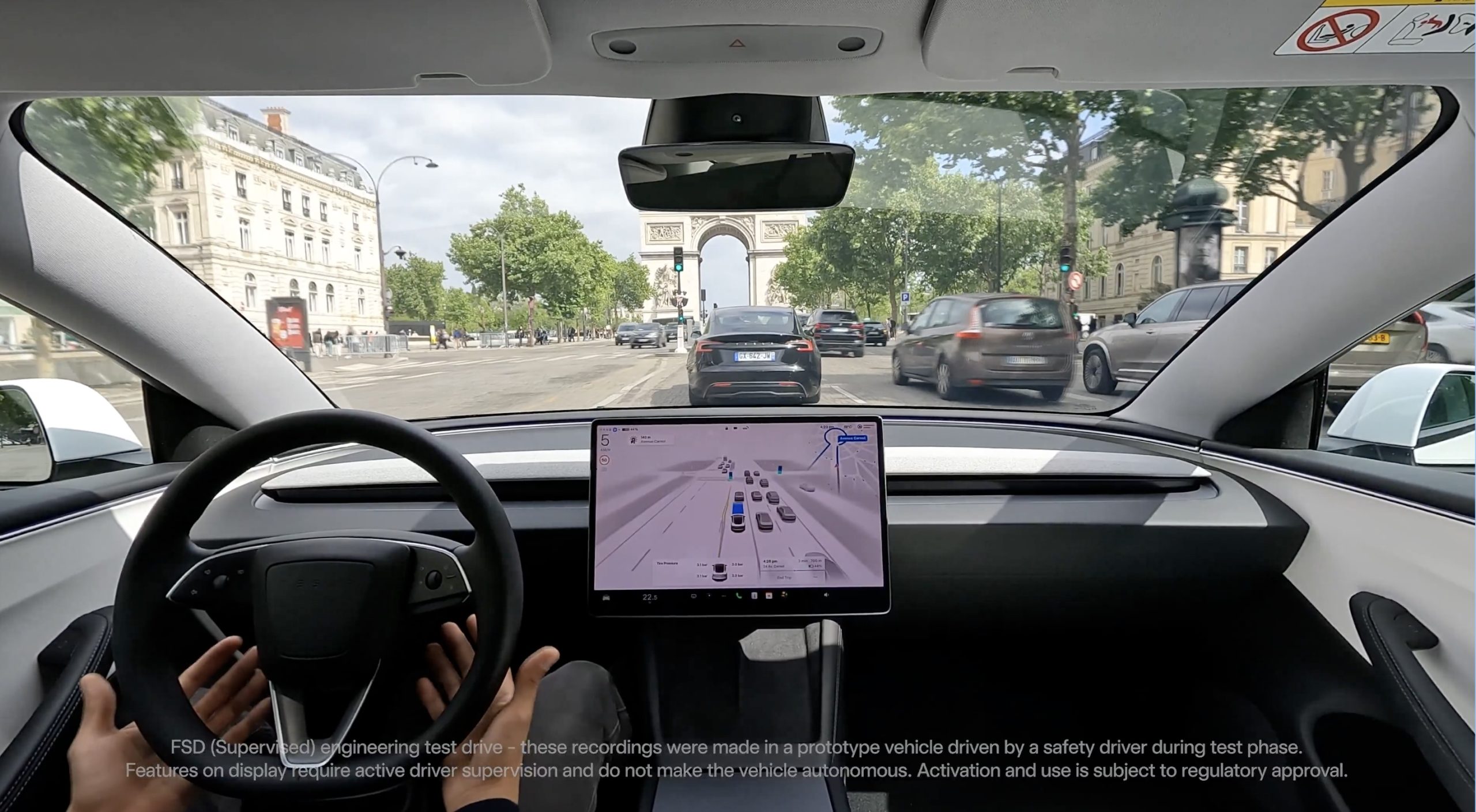
Tesla expanded its new Full Self-Driving program, which gives people the opportunity to experience the company’s suite, in Europe.
Tesla recently launched an opportunity for Europeans to experience Full Self-Driving, not in their personal vehicles, but through a new ride-along program that initially launched in Italy, France, and Germany back in late November.
People could experience it by booking a reservation with a local Tesla showroom, but timeslots quickly filled up, making it difficult to keep up with demand. Tesla expanded the program and offered some additional times, but it also had its sights set on getting the program out to new markets.
It finally achieved that on December 9, as it launched rides in Denmark and Switzerland, adding the fourth and fifth countries to the program.
Tesla confirmed the arrival of the program to Denmark and Switzerland on X:
Now available in Denmark & Switzerland
🇩🇰 https://t.co/IpCSwHO566 https://t.co/V2N5EarLNX
— Tesla Europe & Middle East (@teslaeurope) December 9, 2025
The program, while a major contributor to Tesla’s butts in seats strategy, is truly another way for the company to leverage its fans in an effort to work through the regulatory hurdles it is facing in Europe.
Tesla has faced significant red tape in the region, and although it has tested the FSD suite and been able to launch this ride-along program, it is still having some tremendous issues convincing regulatory agencies to allow it to give it to customers.
CEO Elon Musk has worked with regulators, but admitted the process has been “insanely painful.”
The most recent development with FSD and its potential use in Europe dealt with the Dutch approval authority, known as the RDW.
Tesla says Europe could finally get FSD in 2026, and Dutch regulator RDW is key
Tesla said it believes some regulations are “outdated and rules-based,” which makes the suite ineligible for use in the European jurisdiction.
The RDW is working with Tesla to gain approval sometime early next year, but there are no guarantees. However, Tesla’s angle with the ride-along program seems to be that if it can push consumers to experience it and have a positive time, it should be easier for it to gain its footing across Europe with regulatory agencies.
News
Tesla ramps hiring for Roadster as latest unveiling approaches
Tesla published three new positions for the Roadster this week, relating to Battery Manufacturing, General Manufacturing, and Vision Engineering.
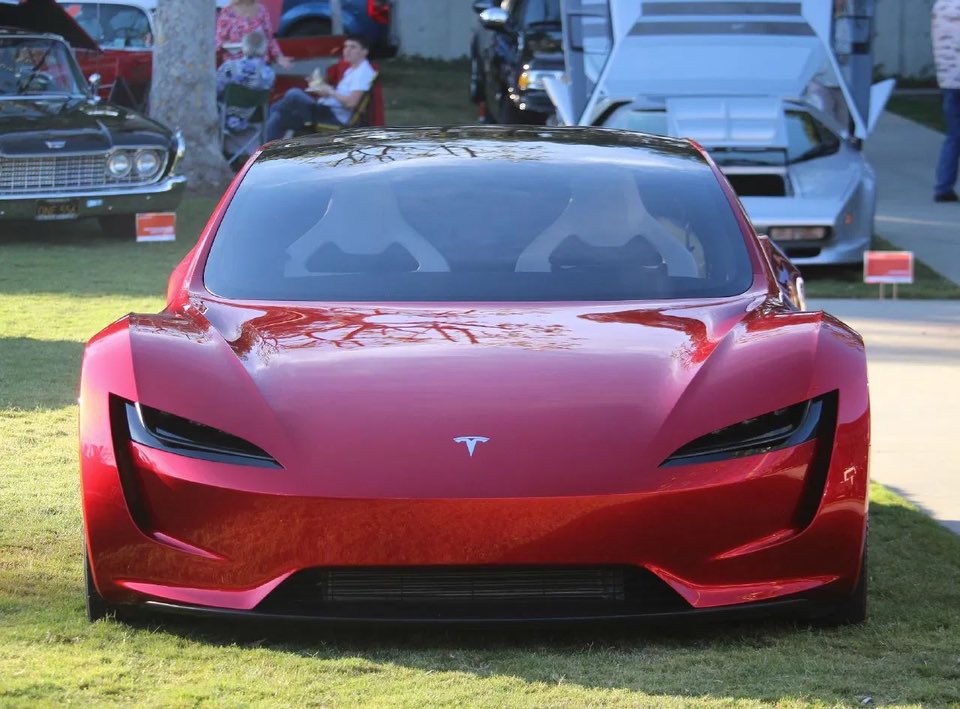
Tesla is ramping up hiring for positions related to the Roadster program, the company’s ultra-fast supercar that has been teased to potentially hover by CEO Elon Musk.
The company seems to be crossing off its last handful of things before it plans to unveil the vehicle on April Fool’s Day, just about four months away.
Tesla published three new positions for the Roadster this week, relating to Battery Manufacturing, General Manufacturing, and Vision Engineering. All three are located in Northern California, with two being at the Fremont Factory and the other at the company’s Engineering HQ in Palo Alto.
Technical Program Manager, Battery Manufacturing
Located in Fremont, this role specifically caters to the design of the Roadster to factory operations. It appears this role will mostly have to do with developing and engineering the Roadster’s battery pack and establishing the production processes for it:
“You will foster collaboration across design engineering, manufacturing, quality, facilities, and production to align with company priorities. Additionally, you will understand project opportunities, challenges, and dependencies; translate scattered information into concise, complete messages; and communicate them to every team member. As the business process development lead, you will develop, maintain, and implement tools and processes to accelerate battery manufacturing execution, achieve cross-functional alignment, and deliver highly efficient systems.”
Manufacturing Engineer, Roadster
Also located in Fremont, this role also has to deal with the concept development and launch of battery manufacturing equipment. Tesla says:
“In this role, you will take large-scale manufacturing systems for new battery products and architectures from the early concept development stage through equipment launch, optimization, and handover to local operations teams.”
Manufacturing Vision Engineer, Battery Vision
This position is in Palo Alto at Tesla’s Engineering Headquarters, and requires the design and scale of advanced inspection and control systems to next-generation battery products:
“You’ll work on automation processes that directly improve battery performance, quality, and cost, collaborating with world-class engineers in a fast-paced, hands-on environment.”
Developing and deploying 2D and 3D vision and measurement systems from proof-of-concept to deployment on high-volume battery manufacturing lines is part of the job description.
Roadster Unveiling
Tesla plans to unveil the Roadster on April 1, and although it was planned for late this year, it is nice to see the company put out a definitive date.
Musk said on the Joe Rogan Experience Podcast in late October:
“Whether it’s good or bad, it will be unforgettable. My friend Peter Thiel once reflected that the future was supposed to have flying cars, but we don’t have flying cars. I think if Peter wants a flying car, he should be able to buy one…I think it has a shot at being the most memorable product unveil ever.”
Production should begin between 12 to 18 months after unveiling, so we could see it sometime in 2027.








